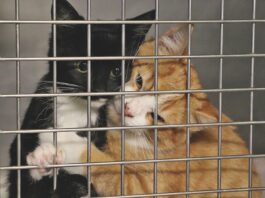Whats the Cause of Wailing And Howling at All Hours?
Cats can be very vocal creatures, and they are very good at getting their owners attention, often at inconvenient times of the day or night. There are a number of reasons that a cat may vocalize in this manner, ranging from normal to indicating disease, and I hope that I can provide some advice regarding the next steps to take in determining what is causing her to behave in this way.
Download the Full October 2016 Issue PDF
If your cat enjoys other pets, is even-tempered and not easily rattled by change, consider sending him to a boarding facility. The International Boarding and Pet Services Association, www.ibpsa.com, offers training and encourages members to cultivate strong relationships with local veterinarians, says Director Carmen Rustenbeck. She recommends choosing a facility with a trained staff who welcomes questions.
Considering Pet Sitting or Boarding?
Cats crave routine and seem to be in sync with your work schedule. But they know that the daily routine is about to be upended when they see you bring out the dreaded suitcase. Even though you look forward to a much-needed vacation, you may find yourself worrying about how your cat will fare during your absence.
Download the Full September 2016 Issue PDF
Another way to make life more fulfilling for cats: Enrich the environment. Cats like to look out windows and see birds, Dr. Houpt says. They will greatly appreciate a viewing perch, such as a cat tree. You can also simulate outdoor life by playing games that allow them to stalk and hunt prey-such as a tossed catnip mouse or a wand with dangling feathers like Da Bird. I also recommend the CatDancer, a bouncy wire with rugged cardboard dangles, which moves in intriguingly erratic ways. Laser pointers make a dot of light that owners can wave for their cats to chase. And treat balls with holes that release kibble when batted around can keep life interesting while you are away.
Welcoming an Outdoor Cat Indoors
A stray cat has begun visiting your yard and youve been feeding him. Hes open to friendly advances and you wonder if he would benefit from a real home. Or perhaps following a close call, you wonder if your indoor cat, who frequently goes outside, should remain in the house for safetys sake. One significant challenge you may face in transitioning an outdoor cat indoors is an existing cat who doesnt welcome newcomers and attacks the new cat.
Guilty of These Mistakes in Training?
Youve probably seen those clever cats on the Internet praying, rolling over and high fiving and wonder how they do that. All you want is for your cat to stay off the kitchen counter. It may come as a surprise, but you can train your cat to demonstrate a variety of behaviors. The biggest misconception people have about cats is assuming that they cannot be trained. They usually can if we avoid common mistakes in training.
Acupuncture for Cats Heads Mainstream
Dusty was a black and white cat who hissed, swatted and squirmed anytime a veterinarian or technician tried to restrain her for an examination or, worse, tried to draw blood or give an injection. This same cat, however, transformed into a picture of serenity and calm during acupuncture treatments.
Download the Full July 2016 Issue PDF
Last year the diagnostic center and the University of Wisconsin analyzed hundreds of samples to identify the influenza strain in the Chicago area that caused illness in hundreds of dogs. The ability of the avian origin H3N2 canine influenza virus to infect cats was clearly demonstrated in South Korea and China prior to its arrival in the U.S. early in 2015, Dr. Dubovi says. The initial report on the susceptibility of cats to H3N2 was based on a significant outbreak of respiratory disease in an animal shelter housing both cats and dogs. Experimental studies also confirmed the ability of H3N2 to infect cats.
In Cats, Fear and Shyness Can Look the Same
Not sure if a cat you want to adopt or even approach is fearful or simply shy? Recognizing the difference between the two behaviors can mean the start of a trusting relationship or the onslaught of an attack.A shy cat is more apt to freeze in place and tremble in hopes that you will walk away. A fearful cat will likely flatten his ears, dilate his pupils and deliver a warning hiss before swatting or biting you if you try to touch him.
International Experts Identify Signs of Pain
These are among key 25 signs of pain in cats identified in research at the University of Lincoln in the U.K. Dr. Isabella Merola and Daniel Mills, Professor of Veterinary Behavioral Medicine, surveyed international academics and practitioners with specialties in internal medicine, anesthesiology, oncology, dentistry, behavior, dermatology, ophthalmology and neurology. They say in PLOS One that the resulting list could lead to faster diagnoses and ultimately reduce suffering.
In the News: Kitten Kindergartens Trending at Shelters
A growing number of animal shelters and veterinary clinics around the country are offering kitten kindergartens in an innovative way to socialize kittens and increase their adoptability. Australian veterinary behaviorist Dr. Kersti Seksel developed the program about a decade ago.
Download the Full May 2016 Issue PDF
Advances in treatments are helping people born with congenital heart disease live longer and with greater quality of life. But not all structural problems with the heart can be permanently fixed in childhood. In fact, many treatments that help get these patients into adulthood often need revisiting later in life. Being born with congenital heart disease means being always mindful of your heart health. Some of these individuals, because they have been heart patients their whole lives, are mindful of their diet, exercise and risk factor control.

















